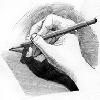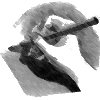|

The
beginner needs only a few inexpensive materials these are the ones
used in his very first lessons.
 |
This is a 5x6"
rendition of and MIB |
Getting
straight to the point. We assume that you know the basics, like
how to hold your pencil recognizing some basic strokes and when
and how to use them. Here are some of those strokes and some techniques
as well.
 Hatching
or cross-hatching is done with diagonal strokes. These strokes are
used to achieve the shade or values on your drawing or illustration.
We would usually start with the diagonal strokes then add the opposing
or cross strokes after we are satisfied with the effect produced
by the first hatches. Hmmmm... are we talking eggs here?? Hatching
or cross-hatching is done with diagonal strokes. These strokes are
used to achieve the shade or values on your drawing or illustration.
We would usually start with the diagonal strokes then add the opposing
or cross strokes after we are satisfied with the effect produced
by the first hatches. Hmmmm... are we talking eggs here??
 Smudging,
it is just as the word means smudge or smear. Same reason, to achieve
the values, but different style and a certain texture and effect.
There are some useful tools used in smudging, the familiar smudging
tool - this is a pencil-like paper stick and your own kneaded eraser
can also be a tool. But our personal favorite the most handy of
them all the finger, with different sizes and length to choose from
plus easy maintenance and very cheap. There's still no eggs here?? Smudging,
it is just as the word means smudge or smear. Same reason, to achieve
the values, but different style and a certain texture and effect.
There are some useful tools used in smudging, the familiar smudging
tool - this is a pencil-like paper stick and your own kneaded eraser
can also be a tool. But our personal favorite the most handy of
them all the finger, with different sizes and length to choose from
plus easy maintenance and very cheap. There's still no eggs here??
 Highlights,
this is the main reason for trying to understand hatching and smudging.
Achieving these highlights, it is what breathes life to a drawing.
You slowly build from light to dark, if you over do it use your
handy eraser to clean some of it off. Try and make your own grayscale
bar the one below was used to achieving the fantastic illustration
above. Highlights,
this is the main reason for trying to understand hatching and smudging.
Achieving these highlights, it is what breathes life to a drawing.
You slowly build from light to dark, if you over do it use your
handy eraser to clean some of it off. Try and make your own grayscale
bar the one below was used to achieving the fantastic illustration
above.
YIPEE!!!
We are done. Sad to say there are no eggs. SO QUIT IT WITH THE EGGS
ALREADY
Here's
an excercise for you to do. Make a grayscale bar similar to the
one below using these two techniques.

|